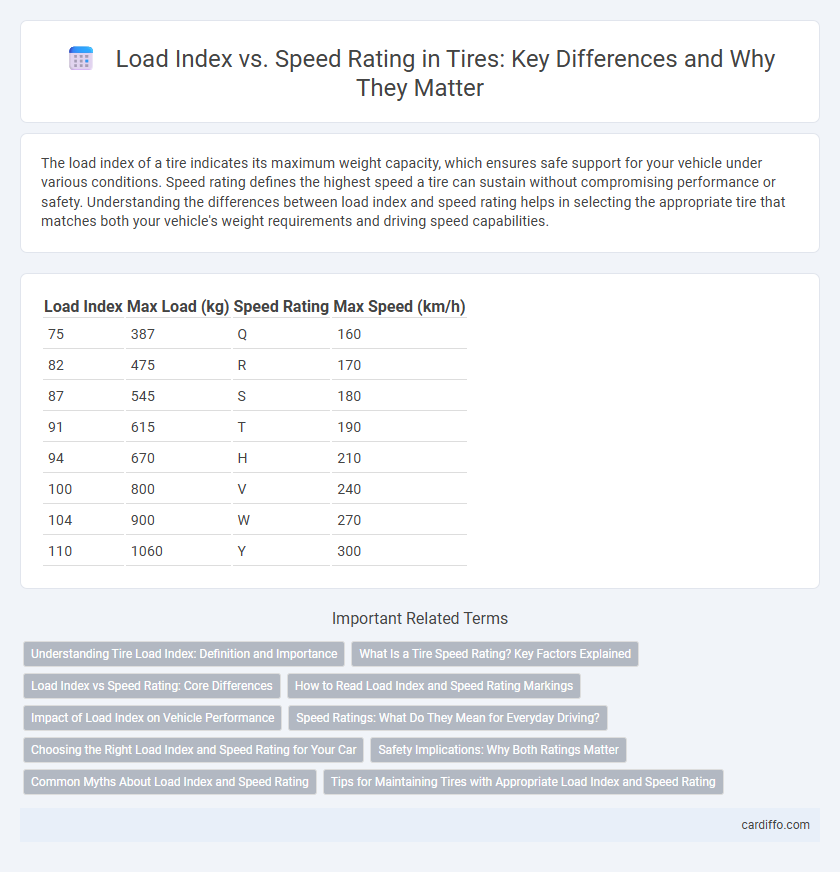The load index of a tire indicates its maximum weight capacity, which ensures safe support for your vehicle under various conditions. Speed rating defines the highest speed a tire can sustain without compromising performance or safety. Understanding the differences between load index and speed rating helps in selecting the appropriate tire that matches both your vehicle's weight requirements and driving speed capabilities.
Table of Comparison
| Load Index | Max Load (kg) | Speed Rating | Max Speed (km/h) |
|---|---|---|---|
| 75 | 387 | Q | 160 |
| 82 | 475 | R | 170 |
| 87 | 545 | S | 180 |
| 91 | 615 | T | 190 |
| 94 | 670 | H | 210 |
| 100 | 800 | V | 240 |
| 104 | 900 | W | 270 |
| 110 | 1060 | Y | 300 |
Understanding Tire Load Index: Definition and Importance
Tire load index represents the maximum weight a tire can safely support at its maximum speed rating, expressed as a numerical code standardized by the Tire and Rim Association; understanding this index is crucial for ensuring vehicle safety, performance, and compliance with manufacturer specifications. Selecting tires with an appropriate load index helps prevent overloading, which can lead to tire failure, reduced handling ability, and increased wear. Proper matching of tire load index and speed rating guarantees optimal tire longevity and vehicle stability under various driving conditions.
What Is a Tire Speed Rating? Key Factors Explained
A tire speed rating indicates the maximum speed a tire can safely maintain under specified load conditions, represented by a letter on the tire sidewall such as H, V, or W. This rating is determined through rigorous testing, factoring in heat resistance, durability, and tire construction to ensure optimal performance at various speeds. Understanding the speed rating in conjunction with the load index is crucial for selecting tires that match your vehicle's speed capacity and weight requirements.
Load Index vs Speed Rating: Core Differences
Load Index measures the maximum weight a tire can safely support, expressed as a numerical value corresponding to specific weight capacities, while Speed Rating indicates the maximum speed a tire can handle under optimal conditions, represented by letters such as H, V, or Z. Load Index is critical for ensuring tire compatibility with vehicle weight, impacting safety and performance, whereas Speed Rating focuses on maintaining tire integrity at various speeds. Understanding the core differences between Load Index and Speed Rating helps in selecting tires that balance vehicle load requirements with appropriate speed capabilities.
How to Read Load Index and Speed Rating Markings
Load index and speed rating markings on a tire sidewall provide crucial information about its maximum load-carrying capacity and top speed capability. The load index is represented by a numerical code that corresponds to a specific weight in pounds or kilograms, indicating the maximum load each tire can support. The speed rating is denoted by a letter indicating the maximum speed the tire is certified to handle safely, ranging from lower codes like "Q" for 99 mph to higher codes such as "Y" for 186 mph.
Impact of Load Index on Vehicle Performance
Load index directly affects vehicle performance by determining the maximum weight a tire can safely support, influencing handling, braking, and overall safety. Proper load index matching ensures optimal tire inflation and wear, reducing the risk of tire failure during high-speed or heavy-load conditions. Ignoring the correct load index may lead to compromised vehicle stability and increased fuel consumption.
Speed Ratings: What Do They Mean for Everyday Driving?
Speed ratings on tires indicate the maximum speed a tire can safely maintain under its specified load capacity, directly impacting vehicle handling and safety during everyday driving. Common speed ratings like H (up to 130 mph) and V (up to 149 mph) ensure optimal performance characteristics such as heat resistance and tread durability at those speeds. Understanding speed ratings helps drivers select tires that match their driving habits and vehicle requirements, enhancing safety and tire longevity.
Choosing the Right Load Index and Speed Rating for Your Car
Selecting the correct load index ensures your tires can safely support the weight of your vehicle, preventing premature wear and enhancing safety. Choosing an appropriate speed rating guarantees the tire can handle the maximum speed capability of your car without compromising performance or durability. Always refer to your vehicle's manufacturer specifications to match the load index and speed rating for optimal handling and safety.
Safety Implications: Why Both Ratings Matter
Understanding the load index and speed rating of tires is crucial for vehicle safety, as the load index indicates the maximum weight a tire can support, while the speed rating specifies the highest safe speed for that tire. Exceeding the load index can cause tire deformation, overheating, and potential blowouts, compromising vehicle control and increasing accident risk. Ignoring speed ratings leads to tire overheating and tread separation, which endangers stability and traction, making adherence to both ratings essential for safe driving performance.
Common Myths About Load Index and Speed Rating
Many drivers mistakenly believe a higher load index means better speed performance, but load index strictly indicates the maximum weight a tire can support, not speed capability. The speed rating, represented by letters such as H, V, or W, exclusively defines the maximum safe speed for a tire under optimal conditions. Confusing these two ratings can lead to improper tire selection, compromising vehicle safety and performance.
Tips for Maintaining Tires with Appropriate Load Index and Speed Rating
Maintaining tires with the correct load index and speed rating ensures optimal safety and performance by preventing excessive wear and potential blowouts. Regularly check tire pressure, alignment, and rotation schedules to support the tire's designed load capacity and speed limits. Use manufacturer-recommended tires that match your vehicle's specifications to enhance durability and driving stability under varied load and speed conditions.
Load Index vs Speed Rating Infographic

 cardiffo.com
cardiffo.com